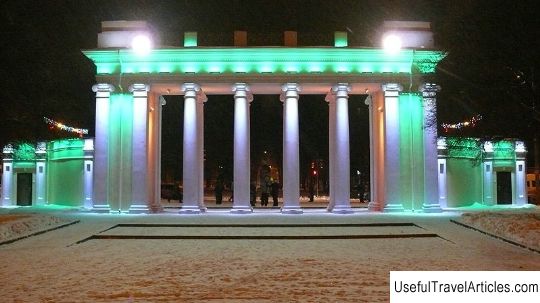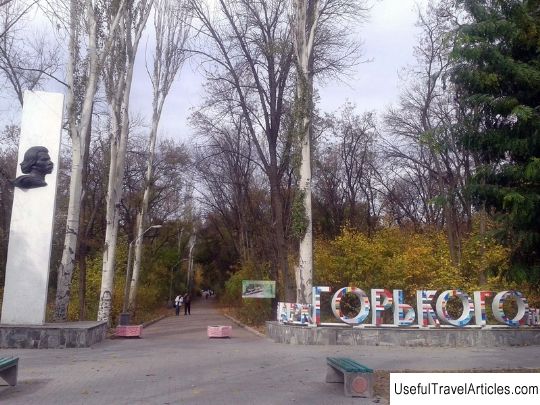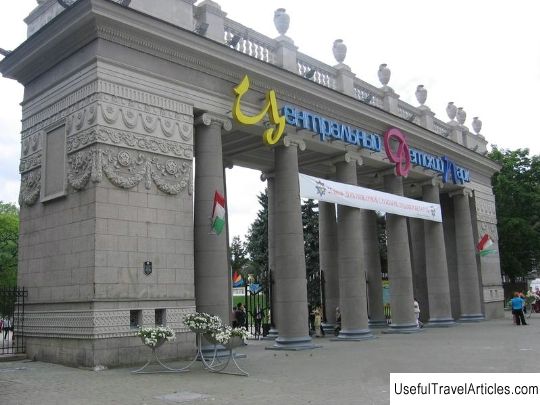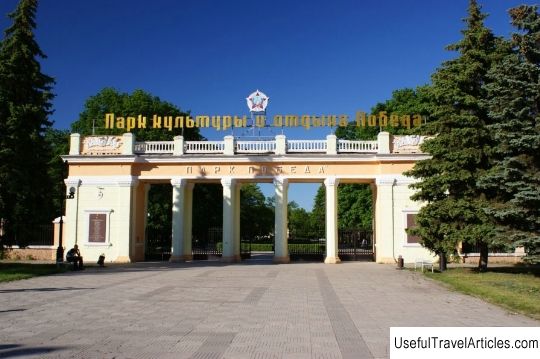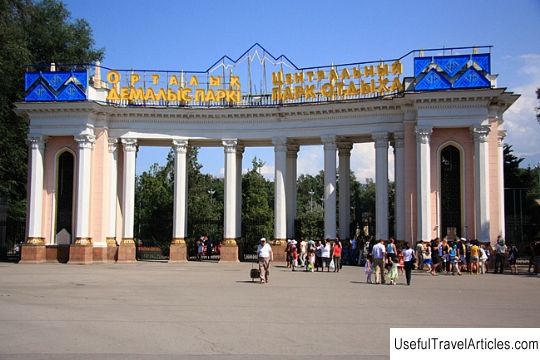Central Park of Culture and Rest description and photos - Russia - Moscow: Moscow
Rating: 7,7/10 (609 votes) 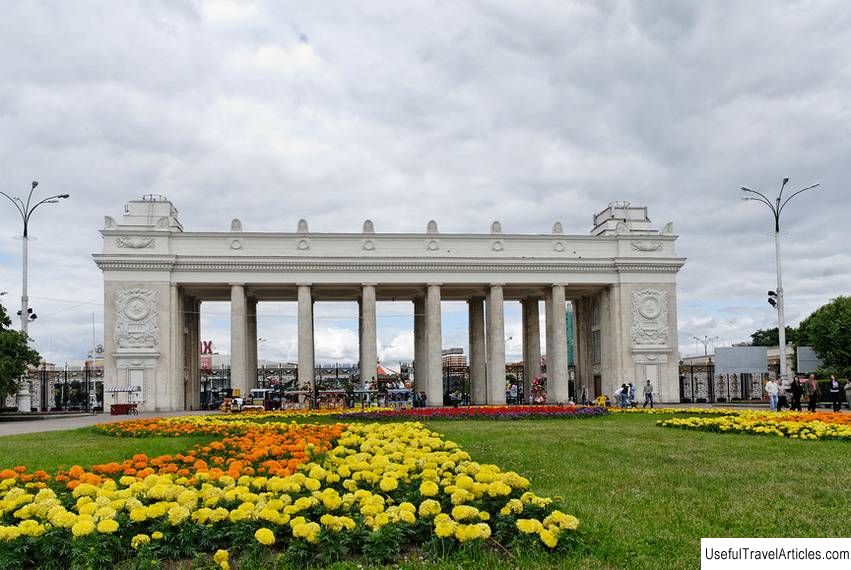
Central Park of Culture and Rest description and photos - Russia - Moscow: Moscow. Detailed information about the attraction. Description, photos and a map showing the nearest significant objects. Photo and descriptionAmong other metropolitan recreation areas, Central Park of Culture and Leisure is best known to guests of Moscow. Gorky Park has existed for 90 years, and during this time it has become a favorite walking place for millions of people and several generations. The Central Park of Culture and Leisure named after Maxim Gorky occupies more than 120 hectares, the number of its visitors reaches 100 thousand people on weekends and holidays. The history of the creation of the Central Park of Culture and LeisureIn the early 1920s, it was decided to hold the first agricultural exhibition in the capital of the young Russian republic. The choice of a place for its organization fell on a section of Krymsky Val Street on the river bank. On the one hand, the future exhibition area was limited by the Neskuchny Garden, on the other, the Vorobyovy Gory adjoined it. I. Zholtovsky's project won the competition for the organization of the exhibition. The exposition of the agricultural and handicraft-industrial exhibition, held in 1923, gave visitors the opportunity to get acquainted with the life of the country and its achievements. The exhibition set the vector for the development of the future park, which it was decided to organize after the closure of the exposition. In March 1928, the government issued a decree on the organization of a park of culture and rest on the Crimean Val , for which the State Bank and the Moscow City Council allocated 700 thousand rubles. A new art council was approved, which included Lunacharsky and Meyerhold , and Konstantin Melnikov became the head of the design department. Visitors came to new park in August 1928 . On the very first day, more than 100 thousand residents of Moscow and guests of the capital became its guests. But work on the creation and development of the object of cultural leisure of workers continued. The government noted that the park should become a "health factory" for Soviet workers, and the first director of the Central Park of Culture and Leisure Betty Glan made every effort to fulfill the tasks. The golden era of the "cultural complex"Betty Glan was a journalist, filmmaker, and generally a very creative person. As director, she chaired the committee that organized the competition for the master plan for the development of the recreation area . The participants of the competition had to submit their ideas for planning and landscaping the territory of the former agricultural exhibition and organizing a cultural and educational program. In 1932 the park was named after Gorky. The proletarian writer celebrated the 40th anniversary of his literary activity. At the same time, Sokolniki and Izmailovsky parks were opened in the capital, so the recreation area on Krymsky Val received the status of a central park. A. Vlasov , whose project under the name Green Theater has become one of the symbols of the Central Park of Culture and Leisure. In the open-air Green Theater, opera performances were staged, dramatic performances were performed, musical concerts were given, and up to 20 thousand people could watch the performances at the same time. No less famous has become parachute tower Central Park of Culture and Leisure. It was called the record holder and the first such structure in the world in the 30s. The first metropolitan sound cinema was also opened in the park. Gorky. It was located in the building of the former shipyard of the Bromley plant, rebuilt in 1932 by the Brazilian architect Dacosta. The global reconstruction of the park took place in 1936, when all temporary pavilions were demolished, Pushkinskaya embankment was faced with granite slabs, and in the center there are observation platforms with a fountain . The alleys of the Central Park of Culture and Leisure have become the main green "lungs" of the Russian capital, as the Moscow development plan envisaged. After the arrest of Betty Glan, accused of Trotskyism, the golden age of the "cultural combine for remaking consciousness" ended, but the development of the park. Maxim Gorky continued for the next decades. During the Great Patriotic War, samples of enemy military equipment captured as trophies on the battlefield were exhibited in the park. In 1945, the restoration of the territory and objects damaged by the bombing began. In the 50s, new stage venues, an observatory with a refractor by Carl Zeiss, the famous Ferris wheel , whose height was 52 meters, and The main entrance - an arch appeared in the Central Park of Culture and Leisure , supported by two dozen columns and became the hallmark of the largest metropolitan park. A glance at the map The Central Park of Culture and Leisure of Moscow includes: - Neskuchny Garden is the largest landscape park in the historical part of the Russian capital. It is located on the right bank of the Moskva River and was formed at the beginning of the 19th century, when the Trubetskoy estate was bought by Nicholas I. The emperor named the ownership of the Neskuchny Garden, and later it included the neighboring areas of the Golitsyns and Orlovs. Nowadays, in Neskuchny Garden you can play tennis and football, work out in the fitness center, go hiking and get acquainted with park buildings, some of which were built in the 18th century. The most famous sights of Neskuchny Garden are the 18th century rotunda Hunter's Lodge, Count Orlov's Tea House and the Bath House with a dome. In the arena on the territory of the Neskuchny Garden, Mineralogical Museum named after Fersman. · Bordering the Neskuchny Garden on the east side, Vorobyovy Gory Park is one of the most beautiful places in the capital of Russia. A sports and tourist complex has been organized on Vorobyovy Gory, where you can practice various sports throughout the year. · The largest museum of sculpture in the city is another part of the Central Park of Culture and Recreation. Gorky. Park of Arts "Muzeon" invites guests to get acquainted with 800 exhibits, which are sculptural portraits of leaders and prominent citizens of the country. The sculptures were made in the first half of the last century. They appeared after the dismantling of monuments to the leader and other Soviet politicians began throughout the country in 1991. In Muzeon you can see the works of Mukhina, Vuchetich, Merkulov and Vilensky. One of the most famous exhibits is the Iron Felix, which previously adorned Lubyanka Square. · And, finally, Parterre is actually the part of the park that was occupied by the agricultural exhibition in 1928 and from where the creation of the Central Park of Culture and Leisure began. General the area of Gorky Park, together with Muzeon, Neskuchny Garden and Vorobyovy Gory, is almost 220 hectares. What to see in the Central Park of Culture and Leisure im. GorkyGoing on an excursion to the park of culture and recreation of the capital, be prepared to the fact that even in a whole day it is impossible to see all its sights and interesting places. The visiting card of the park is The main entrance to the Central Park of Culture and Leisure , built in 1955, when the post-war reconstruction project was being implemented. The monumental structure with 24 columns and two pylons, decorated with metal casting and forged elements, was built according to the project of architects A. Spasov and Y. Shchuko. The height of the portal is 18 meters. Today, the complex of the Main Entrance to the Central Park of Culture and Leisure houses the Museum of Park History , a souvenir shop and the management. Garage Museum of Contemporary Art introduces guests to the works of young Russian artists, and its exposition reflects the current processes taking place in the culture of the country and beyond. The Garage collection is dedicated to the history of contemporary art and invites you to get acquainted with works created in the period from the 50s of the last century to the present day. The sculpture "Girl with an Oar" is a name that has become a household name and designates park statues created in the style of "plaster socialist realism". The first girl was installed in the Central Park of Culture and Leisure in the pool with a fountain as its vertical dominant. The nude statue carried the idea of emancipation to the masses, but stood in the fountain for only a few months. The work of the sculptor Ivan Shadr was criticized for its excessive height, and soon the 12-meter girl moved to Lugansk. Shadr created a smaller sculpture that was damaged during the bombing of Moscow in 1941. In 2011, the recreated Girl with an Oar was inaugurated in the Central Park of Culture and Leisure. Krymskaya Embankment has become a new city attraction after recent reconstruction. Now she has received the status of a landscape park, and its multi-level undulating layout allows you to spend time actively and variedly at any time of the year. On the territory of the Crimean embankment there are bike paths and areas for rollerblading, skiing and sledging, fountains and the zone of artists with the Vernissage pavilion. The history of the creation and development of Gorky Park can be traced in Museum, which opened in the side pylon of the Main Entrance. The exposition is interactive, and therefore it will be interesting for visitors of all ages. On the roof of the Museum of the History of the Park there is a observation deck , through the binoculars of which not only the alleys of the Central Park of Culture and Leisure, but also the famous architectural monuments of Moscow are perfectly visible. In the museum you can take a virtual jump from a parachute tower, which in the 30s of the last century was one of the local symbols. Communicating with animals in the park is another favorite pastime of visitors to the Central Park of Culture and Leisure. Pheasant farms are set up in Neskuchny Garden, on Vorobyovy Gory and on the banks of the Golitsyn Pond. In the Green School you can feed the rabbits, chat with parrots and watch the family of ducks . A swan flock lives in Golitsinsky pond, and squirrels are found in almost all park alleys. In the Central Park of Culture and Leisure, there are vending machines with a special healthy treat for its furry and feathered inhabitants. Children's rest in Gorky Park There is a kindergarten“ M. I.R. ", where kids from one to six are engaged in fine arts and yoga, foreign languages and chess, acting and pottery. The Salute playground has nine individually designed spaces for active recreation. In the "Salute" complex you can play with color and water, sand and sound, shapes and sizes, and therefore its visitors get an invaluable experience in the development of all senses. On the playgrounds "Salut" there are attractions, water slides, a climbing wall, a play tower and mega-swings. In the Green School , students learn everything about the surrounding nature. Lessons in it are devoted to ecology and gardening, and instructors at master classes teach children to draw, cook and create art objects from scrap materials. At the Green School you can hold a celebration on the occasion of a children's birthday,       We also recommend reading Church of Santa Maria dei Carmini description and photos - Italy: Venice Topic: Central Park of Culture and Rest description and photos - Russia - Moscow: Moscow. |

